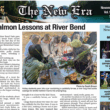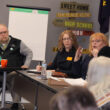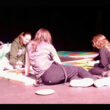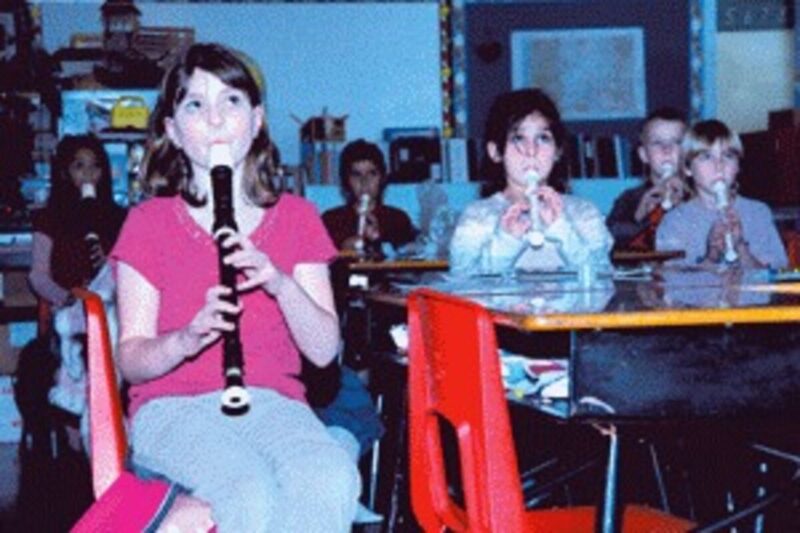Scott Swanson
Of The New Era
It’s Showtime at Crawfordsville School.
Dan Swanson, who teaches third- and fourth-graders at the school, surveys students lined up across the stage and taps his baton. He turns to an overhead projector, which is shining the music onto a large piece of white board, and uses his baton to point out the melody as a chorus of recorders erupts into “Lo, How a Rose E’er Blooming,” an old Christmas carol.
The music continues for two or three minutes, as different sections of the ensemble weave their parts in and out with each other. The song finishes and the crowd erupts in cheers and whistles.
The students bow, awkwardly, then file off the stage.
Another successful performance for the Crawfordsville Recorder Band, which grew out of Swanson’s decision five years ago that his students needed some music in their lives.
Swanson, 55, has taught at Crawfordsville for 14 years, after two years at Foster and some previous teaching experience in Washington County.
“We had music teachers when I first came,” he said. “Years ago, a band teacher would come to the school and teach the fifth- and sixth-graders,. They’d come and they did a little bit with recorders. But those positions were cut.”
When scheduled music instruction for elementary students in the district was eliminated due to tightening budgets, sixth-graders were eligible to play in the junior high band, but the commute into town each afternoon made it difficult.
The cuts didn’t leave many options for the small Crawfordsville staff, several of whom teach more than one grade.
“Since I don’t have much music background and nobody else in the building did, we just used CD’s,” Swanson said, “sing-along-to-a-tape kind of things.”
He decided that wasn’t good enough.
“It started wearing on me that I just wasn’t doing enough for kids in terms of music and all that,” he said.
Swanson attended a week-long workshop on the arts, put on by the state Department of Education, that dealt with recorders, fine arts, painting and drawing.
“I came back thinking I needed to do more,” he said. “I had to do what I could with what I had.”
What he had was a couple of college elementary music classes and some music experience at church, “but that didn’t turn me into a musician,” he said. “I played the guitar and sang. I could play chords. I could read notes, but I was slow.”
His wife, Tiah, can play the piano and guitar and sing, he said, and she gave him some help.
Swanson found some recorders at Crawfordsville, enough to get started. He began teaching his third- and fourth-grade class, and the fifth- and sixth-graders in two separate groups.
He taught them to play the recorders, which are simple woodwind instruments. Last year he applied for and received a $1,500 grant from Target for the purchase of music and more instruments – some bass, tenor and alto instruments to go with the sopranos he already had.
Then retired district band teacher Ken Collins came by and told Swanson that there was a stash of tenor and alto recorders and one bass at the high school.
“They’d been there for years, I guess,” Swanson said. He arranged to procure those instruments, which further broadened the capabilities of his band.
It’s been a learning process for everybody, but it’s worked.
“I ve done it differently through the years and hopefully I’m getting a little better,” Swanson said. “When we were just doing the sopranos (instruments), it was a little easier.”
He said he didn’t require students to learn to read music in the beginning, but started shifting toward learning notes.
Swanson noted that when someone learns to read printed material in a book, the eye sees what’s on the page and the mind interprets it. Musical instruments require the process to go to another level as, after the mind interprets what the eye sees, the information has to be converted to finger movement and the breathing may need to be in sequence.
“It’s easier for some kids than for others,” he said. “Some of them are more kinetic learners.”
Band practice is usually held two or three days a week, and Swanson switches with fifth- and sixth-grade teacher Bret Bowers, who teaches PE or Spanish to Swanson’s students while his class is learning music. He said practice intensifies before a performance, then drops off a bit.
“We sacrifice art class for this,” he said.
Students’ were generally favorable when asked what they thought of the class.
“It gives other kids a chance to read notes,” said Ashley Dern, who plays the alto recorder. She also plays the piano and guitar, she said.
Victor Stupin, a sixth-grader in his second year of the band, said he likes the sounds the ensemble makes.
“It teaches you something new,” he said of the class. “If you’re at your house and you have nothing to do, you can get an instrument and play.”
Fourth-grader Hannah Smith, who plays the tenor recorder, said she started learning the recorder in third grade.
“I like it because you learn a lot of tunes and music,” she said, adding that she particularly enjoyed playing “Hot Cross Buns,” a tune the band played last year.
Sixth-grader Cassie Johnson, who plays bass, said the class isn’t necessarily fun, “but it’s entertaining.”
She said that one of the difficulties is “the fact that we have to sit there for 45 minutes and don’t get to play” (while other sections of the band are working on their parts.
Swanson said he enjoys listening to it all come together.
“I like the sound that they make,” he said. “They drag their feet, but when we put it all together, they get really quiet because they know that they sound really cool. That motivates them and it motivates me. It’s a lot of work to get there, though.”
Collins, the retired district music teacher, said he’s pleased that Swanson has stepped up to fill a need at Crawfordsville.
“I think it’s great,” he said. “This is truly one of the more positive things that’s happening in music in this district.”
Collins noted that research indicates children who study the arts often do better in other subjects as well.
“It’s been proven that the more years they take music, the higher their SAT scores,” he said. “When I was teaching, I taught every third-grader piano keyboarding for two years. Keyboarding develops right and left-brain connections through the corpus callosum (the band of fibers uniting the two halves of the brain), which helps higher mathematics.”
Collins said that research has shown that about age 12 the brain begins “a clipping process of any connections the brain has not made” between its left and right sides.
He said another benefit of the arts is that they help some children enjoy school.
“Even the two-week things they’re doing now, it’s surprising how excited certain kids get about this,” he said of the brief seminars in the arts that some local schools are holding. “It affects their behavior in class.”
Swanson said parents often are appreciative after they hear the children perform.
“When kids do something really well, there’s a hush, quiet before they applaud. You know they appreciate it.”
He said he had one parent tell him that their child wanted to take piano because the student enjoyed music.
But the real point, Swanson said, is to give his students a chance he didn’t have.
“When I was in school, we didn’t have music,” he said. “As I grow older, I regret that I didn’t have that opportunity.
“One of my goals is that when kids leave school here, they’ll be able to play one simple instrument and be able to read music. I’d like to see the kids have an opportunity I didn’t have.
“It’s limited to my skills and understanding, but it’s still an opportunity.”
Editor’s note: Though the writer and the subject of this article have the same last name, they are not related.





